Daser posts, Saturday 12/3/05
Please see original version on http://asistdaser.tripod.com/daserblog/index.blog?from=20051203
Saturday, 3 December 2005
Peiling Wang, UTK: Research-related Use of Internet-enabled Information Resources Mood:  on fire
on fire Notes by Christina Pikas
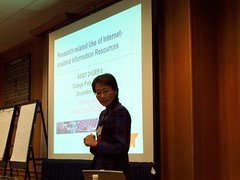
Preliminary study, but she believes that it will scale up. Standard deviation is very small.
Purpose
- identify interdisciplinary differences in the use of internet-enabled information resources for research (not just technology rich or poor, rather, the type and nature of the research)
- identify factors affecting use or nonuse of these resources
- influence design
Research Questions
- which internet information technologies are used in research
- who are these technologies used in information seeking (model of 6 types of information seeking (Ellis?))
- how important are each
Research Design
- indepth f2f interviews
- semi-structured questions (her guide is available ask her)
(for how does each tech type support each of the 6 of Ellis' types, plus one more type: organizing)
What percentage of your needs are met by electronic resources?
Chaining - forward or backward citation searching
Participants
Productive and active researchers (faculty and doctoral students):
Computer Science
Engineering
Information Science
Journalism
Humanities/Social Sciences (not yet complete)
In progress - 42 interviews right now
Preliminary results
- average 5-7
(sorry for the poor table)
| importance | cs | eng | is | JEM
|
| 1 | web | db | db | web
|
| 2 | email | web | web | opac
|
| 3 | e-j | ftp | e-j | database
|
| 4 | dlib | opac | opac | email
|
| 5 | opac | email | email | e-j
|
What % e-resources? Eng highest, CS next, InfoSci next....
2 outliers
1-CS prof, 100% electronic
2-Journalism prof, 98% print
Factors affecting use:
- nature and type of research
- availablity of digital archives (humanities, historians)
- accessibility of digital archives
- awareness of the resources
- usability of the internet technology
- perception of source quality and reliability
- individual preferences & constraints
strategies
do not save (search again)
do not delete (periodically discard all)
create folders and subfolders
save multiple copies on multiple machines
keep a print copy of the digital documents
work group maintained collection
Implications
- information seeking in the digital age is easier for some but harder for others
- user tools for diverse users
- revamp the metaphor of folders
- provide easy access to digital objects at an atomic level (disaggregation)
daser2005Updated: 12/5 to add tag and picture
Marie Martens, BioMed Central: Open Access, Moving into the Mainstream Mood:  a-ok
a-ok Notes by Christina Pikas
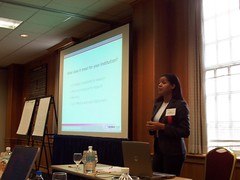
Subject areas embracing open access
- bioinformatics
- cancer
- arthritis
- public health
- infectious diseases
senior authors believe article downloads more credible than citations (?)
(independent study by CIBER: http://www.ucl.ak.uk/ciber/ciber_2005_survey_final.pdf)
"All truth passes through three stages.
First, it is ridiculed.
Second, it is violently opposed.
Third, it is accepted as being self-evident"
Arthur Schopenhauer
daser2005Updated: 12/5 to add tag and picture, correct glaring spelling problem
Karla Hahn, Association of Research Libraries: Institutional Repositories, Emerging Frontiers for Policy Making Mood:  not sure
not sure Notes by Christina Pikas
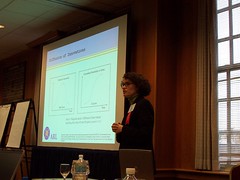
She's citing Wikipedia :)
Diffusion of Innovations.
Pattern at which people adopt successful innovations .. Everett Rogers.
We're down at the beginning. Westrienen and Lynch D-Lib June 2005 (limitations on data), table, number of IRs per country, number of docs per IR. In September D-Lib, article by Lynch and Lippincott on US IRs.
(see:
Academic Institutional Repositories: Deployment Status in 13 Nations as of Mid 2005
Gerard van Westrienen, SURF Foundation; and Clifford A. Lynch, Coalition for Networked Information
doi:10.1045/september2005-westrienen
Institutional Repository Deployment in the United States as of Early 2005
Clifford A. Lynch and Joan K. Lippincott, Coalition for Networked Information
doi:10.1045/september2005-lynch)
Other work by Foster and Gibbons, Jan 2005 D-Lib
Three main barriers from Foster and Gibbons articles:
- our language, jargon... users don't know IR, metadata, etc
- time ... to find out about IR, understand why and how to use it...
- copyright
A la Clifford Lynch, IRs are sets of services, not softwares
"Never forget posterity when divising a policy. Never think of posterity when making a speech." Robert Menzies, former Prime Minister of Australia
Policies
Copyright
- authors do not understand their rights, options
- publishers encourage authors to regard as pro forma that they transfer all rights to the publisher
- practices are not consistent among authors, publishers
Peer review
- chicken - egg, get content to look at quality, look at quality to get content
- this is more than just being peacocks, it's their bread and butter, life and death of their careers
New models for scientific works
- MIT CogNet
- Real Climate
- Columbia Earthscape
Digital data
- more on long-lived data (mentioned at ASIS&T, read document here)
- data management plans
Commercialization and content control
- previously, limiting access to make money
- we are not home free
Investment - who pays?
Threats
- underinvestment (investment in science scholarly communication systems has not kept pace with funding in science... can't keep cancelling journals to build repositories, that is not sustainable)
- copyright over-management, under-management
- commercialization
Opportunities
- good that we've jumped on this in new and potentially risky roles, and taken this as a job for librarians
Comment from the audience
- tension also exists between roles as editors, authors, researchers (within the same person)
daser2005Updated: 12/5 to add tag and picture
Leslie Johnston, UVa: Repository Development at the University of Virginia Library Mood:  sharp
sharp Notes by Christina Pikas
She is discussing a curated digital library. It's been around since 2003.
Fedora: Flexible Extensible Digital Object Repository Architecture
Not an out-of-the-box repository, it's the underlying toolkit that is a Digital Asset Management architecture (Mellon funded, UVa and Cornell, for the software development, but not for their implementation)
Assumptions
- part of a global network of repositories
- all media types
- searching and browsing equally important
- curated
- primary users UVa community, they do have restricted content
- they'd like to have all digital collections in this repository
Process
Phase I, 2003, prototype
- electronic texts from the library's special collections
- art architecture ...
- got a lot of feedback (130 comments), they categorized, ranked, prioritized them
- number one comment: have more stuff
Phase II, Fall 2004 (final for Fall 2006)
See
her article in D-lib for information on testing.
What did it take?
Standards
- ad hoc group documented production standards for media files
- metadata steering group documented local encoding practice, minimum standards, mapped various standards to the local standard
- community digitization standards
Content production
- subject librarians select, with technical assessment (ease of production, need for metadata enrichment, time constraints such as instructional deadlines, funding)
- centralized digital library production service (w/7.5 FTE plus student "scanning monkeys")
- new software tools and scripts
Development
- working groups for functional requirements
- functional requirements and analysis of media files and metadata to document content models (classes of objects and behaviors and mechanisms)
- processes for ingest
- interface
- search
Technology
Developers
- they had no budget
- they borrowed people from other parts of the library
Library Content
- huge queue of stuff to be done
- science stuff (herbarium images, glass astro slides from the parallax project)
Faculty Content
- born digital
- digital humanities projects
Support- librarians, programmers
D. Stern - seems intimidating, but it only took 3 programmers 2 weeks to be able to add info
Marie Martens, BioMed Central: Open Repository Mood:  spacey
spacey (spacey as in dspace :) )
Notes by Christina Pikas
They are basically a hosting facility for Dspace for institutions that can't host in-house (openrepository.com).
Services
- complete set up within 3 months
- technical support
- hosting
In-house solution has a lot of hidden costs. They have predictable costs -- set-up and maintenance.
The hierarchy is communities and collections. She then went through what it looks like to upload papers and showed an example implementation at UConn.
According to Stevan Harnad, the trouble isn't setting up the software, it's getting the content. (he talked about http://www.eprints.org/, his product, which also offers hosting)
Question from Vivian Siegal - would I have to submit three times - to the journal, to the NIH repository, to my institution? -- no they have automatic feeds.
Mary Steiner, Penn Library: The Toddler Years for ScholarlyCommons@Penn Mood:  chillin'
chillin' I've been forgetting to sign my posts so I will do it at the start and re-edit the others.
Notes from Christina Pikas
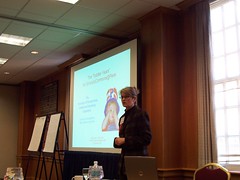
Why get into this business anyway?
(partial list, changes over discipline and over time)
- access to information, highlight student work, stable archives
- specific desire of a campus unit (at Penn, Eng.)
- campus climate (centralized, funding structure, top down vs. grassroots, relationship between IT/library/archives)
- improve visibility/stature of academic research and scholarly activity
Scope and Nature
- short term, where to start, pilot, seeding the repository
- long term, across campus, cooperation
- pilot: the best work from the School of Engineering & Applied Science, recent work, with the endorsement of the leadership
Implementation
- oversight (IT, cataloger, administration, license/copyright person from serials)
- they chose the PQ product to get a turn-key solution with less burden on library and university IT
- f/t only
- they took on the burden of copyright compliance (to encourage submissions without reading through and complying with extensive publisher-specific policies)
(according to Stevan Harnad, you can just put everything up, and make f/t only available to the institution where required, then provide author e-mail and suggest that outsiders send e-mail asking for e-print, then author can send an e-print from the repository)
Operations -- getting content
- submit via e-mail
- harvesting faculty web pages
- alerts on relevant databases, e-mail authors
Going public
- timed the launch (not over break)
- marketed via demos, write-ups, mailings, links, share statistics
- registered with search engines
Assessment
daser2005Updated: 12/5 to add tag and picture
Jeff Riedel, ProQuest: Alternative Models of Scholarly Communication Mood:  caffeinated
caffeinated Notes by Christina Pikas
Back after the break. Change in order, we're now on to sessions again...
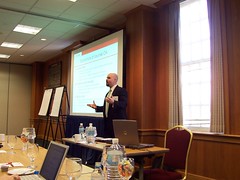
Digital Commons is their product... current implementations, UConn, TexasTech....
Other products eprints at SOTON and Dspace. About 500 institutions now have institutional repositories. See http://www.oaister.org for a sample.
Right now
- majority of objects still text-based
- some disciplines are more likely than others
- discovery paths (75% general web search engines -- going right to the paper, 7% front door, 19% referral/e-mail/direct access). Google acces starts at about 90% and then drops to about 40% years later when the IR is established. OAI has very few referrals -- they've done a good job marketing to producers but not to users.
More on marketing OAI
- more content
- better tools can be built on oai, but haven't yet
- needs to be a part of federated search implementations
Challenges and answers
- content recruitment
- no pain for the researchers (yet!), they have to know that it will benefit them first
- regular e-mail reports (your paper has been downloaded x times)
- branded personal researcher pages (contribute to their egosystem)
- citation harvesting
Their product includes a journal publisher module with peer review management, etc.
- see Boston College,
Studies in Christian-Jewish Relations (open access)
The overlap of IR and OA
- Both eliminate costs with accessing scholarly info (really move the cost)
- Possible because of the internet
Bottom line-
This will not help the stranglehold publishers have on institutions (yep!) -- institutions still pay, maybe not the library.
"There's money in the system. You can move it around, but it can't disappear without a quality loss"
daser2005Updated: 12/5 to add tag and picture and to sign the top
Vivian Siegel: Building an Open Access World Notes by Christina Pikas
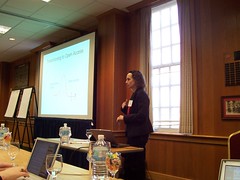
What it's like to launch an open access journal (she was at
PLOS).
PLOS uses Berlin definition of Open Access -- not only to read, but to reuse content.
Why open access?
- matches the needs to the researchers as readers and authors
- matches the goals of the funders of the research
- best meets the publishing mandate to widely and rapidly disseminate information
Starting vs. Transitioning to OA
developing reputation vs. established reputation
building submissions, readership, usage (same as with any new journal) vs. established
no legacy data concerns vs. legacy data
can set expectations vs. legacy economics
Additional challenges at PLOS
Building an organization
Possible because of...
- philanthropy
- credibility within scientific community
- support from scientific and library communities
To build submissions...
- Kept an updated list of authors who had papers accepted
- Impact factor!
How to do you fund...
- philanthropy
- author charges
- memberships
- advertising
- commercial reprints
- a la BMJ - value-added material subscribers only, research open access
- print supports online
Costs to publishing
- copy editing
- figure manipulation
- professional editors
- front section
- fee waivers
How do you build an open access world?
- have open access options for traditional journals (like the PNAS model)
- front section subscription only (BMJ)
- put open access in researchers evaluation model
- put aside the money in the funding so that it can't be spent elsewhere.
- reduce the costs of publication (print on demand, more control and responsibility to authors for copy editing and figure manipulation, better open source publication management software)
daser2005Updated: 12/5 to add tag and picture, signature
Bob Kelly, APS: Expanding Readership in Theoretical and Experimental Physics Mood:  bright
bright Notes by Christina Pikas
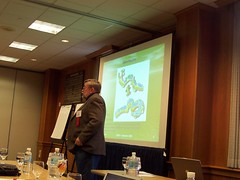
Anton Chekhov, "there is no national science just as there is no national multiplication table, what is national is no longer science..."
History:
1994 APS workshop: publishing preprints on the web is not pre-publishing for submission purposes
Dropped page charges (for all but PRL)
1995 NRL first institutional repository (TORPEDO)
1998 Physical Review Special Topics Accelerators and Beams -- did not charge, libraries reluctant to catalog since they weren't paying for it.
They (like IOP) are moving away from journals towards articles and collections and integrated collections. (note: this has a lot of implications in a lot of spheres, I believe we discussed this at a PAM session at SLA WRT IOP)
He compared institutional subscriptions (now) with the way it was in the late '90s: individual subs, group/department subs, and library subs. Individual subscriptions have doubled in cost, but in general institutions are paying less because access is available across the institution with the online and with the single print copy in the library. hm.
New Services
- ENTS: essential non-text stuff (ex. holograms)
- RSS
- wikis
- folksonomies
- blogs
- full text xml, single column pdf
Copyright statement - has been evolving, but according to Stevan Harnad (audience) has been a step ahead and was the first green publisher (meaning allows self-archiving, etc)
They're looking at non-traditional revenue sources such as archives back to 1893.
daser2005Updated: 12/5 to add tag and picture, signature
Steve Moss, IOP: Open Access Perspective from an STM publisher Mood:  bright
bright Notes by Christina Pikas
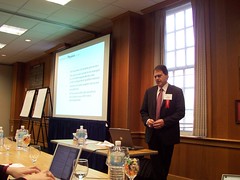
He introduced IOP.
IOP's Open Access Initiatives
1) This month's papers (current 30 days' worth of papers available at no charge on the web page)
2) IOP Select (editorial boards select the best and highest impact papers and make them available at no cost)
3) New Titles (are freely available for up to 2 years)
4) Developing Countries
5) Open Access Journals (New Journal of Physics, Conference Series, Journal of High Energy Physics)
These efforts
- have not increased cancellations
- downloads and submissions are up
- upgrades and subscriptions are up
- has helped impact factors (10 titles more than 20%)
- 18% of the downloads are free, not to subscribers
Expect to break even for a year in 2007 (started publishing in 1998) ... sufficient impact, viable only in long term, requires deep pockets to get there.
See presentation online to see extracts from recent studies on why authors choose to publish where they do. For one study, see
Mary Waltham's site. For another see
APLSP.
daser2005Updated: 12/5 to add tag and picture, signature
Introductions... Mood:  caffeinated
caffeinated Notes by Christina Pikas
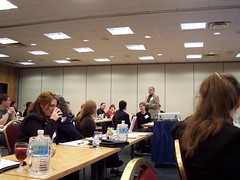
We're now doing introductions. There are people here from IOP, APS, AIP (so physics is well represented), Springer, Biomed Central, and other academic, governmental, and corporate organizations.
High energy physics, medicine, astronomy, chemistry, and engineering environments are all represented.
daser2005Updated: 12/5 to add tag and picture, signature













